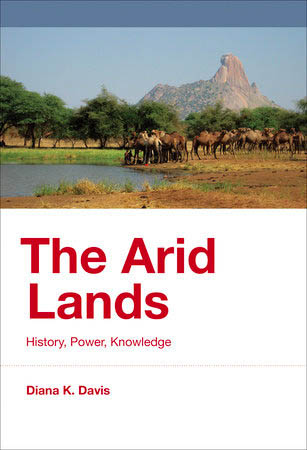Of Deserts and Decolonization: Dispelling Myths About Drylands

Our most common conception of deserts and arid lands is that they are ruined wastelands with little value, aberrations that need to be repaired and improved. Up to 70 percent of global arid and semiarid lands are frequently claimed to be suffering from varying degrees of ‘desertification’1 — despite the term having no agreed-upon definition or standardized measure. This problematic notion of the drylands — which constitute about 40 percent of the earth’s landmass — informs both knowledge about, and policies in, desert regions.

Academic research, however, has shown for more than 25 years that estimates of desertification have been significantly exaggerated and that most of the world’s drylands are not being invaded by spreading deserts caused by deforestation, burning, and overgrazing, as is often claimed. That hasn’t stopped the misconception from fueling a multimillion-dollar global anti-desertification campaign driven by perceptions of a looming crisis.
While global concern about desertification is most commonly dated to the 1970s when the Sahelian drought and famine hit that region with spectacular suffering and mortality, fear of invading deserts has driven global dryland policy for much longer, dating to the mid-20th century with UNESCO’s Arid Zone Program and to various colonial adventures in the world’s drylands long before that.
In a very real sense, our old fear of desertification has caused dryland degradation where, for all intents and purposes, none existed before.
Indeed, before the word “desertification” was coined in the 1920s by a French colonial forester, western imperial powers had executed many different programs to try to curtail the perceived spread of deserts and also to try to “restore” the drylands to productivity. Underlying these attempts was a complex, long-standing, and primarily Anglo-European understanding of deserts which equated them with ruined forests much of the time.2 The assumption that the world’s drylands are worthless, deforested, and overgrazed landscapes has led, since the colonial period, to programs and policies that have often systematically damaged dryland environments and marginalized large numbers of indigenous peoples, many of whom had been using the land sustainably.
The most significant environmental problems that have resulted from the drive to repair drylands and to extract value include salinization from overirrigation, inappropriate “reforestation,” the extension of agriculture into marginal lands, and failed range “improvement.” Although these forms of dryland degradation became problems early in the colonial period, they all persist and continue to pose significant problems today. Of the relatively few contemporary cases of serious dryland degradation, the vast majority are found in places with strong political economic forces shaping development, such as capitalist expansion, authoritarian rule, and the developmentalist state.3 These cases are also directly tied to the devaluing and suppression of indigenous production systems and the local knowledge of dryland populations, often based on the assumption that they have ruined the land.
In a very real sense, our old fear of desertification has caused dryland degradation where, for all intents and purposes, none existed before. Some scholars have dubbed this “policy-induced desertification.”4
Irrigation in arid environments without adequate drainage often results in salinization, waterlogging, the consequent loss of agricultural productivity, the spread of water-associated diseases, and other related environmental effects. Human-induced salinization created serious problems for crop productivity and public health in parts of India during British colonization. And the Soviets’ use of irrigation in the arid Aral Sea drainage basin in order to grow cotton in what are now the Central Asian states of Uzbekistan, Turkmenistan, and Kazakhstan resulted in not only the salinization of half the cotton-growing areas but also the desiccation of the Aral Sea and the production of wind-blown saline sediments that have lowered crop yields and contaminated pastures in other areas. Egypt’s mammoth Aswan High Dam and the associated increase in perennial irrigation also spawned grave problems with salinization, the spread of the debilitating parasite schistosomiasis, and the erosion of the Nile Delta due to silt deprivation. Many other examples exist of problems with salinization and other aspects of irrigation in arid lands around the world that are deemed land degradation by the majority of scholars.
The concept of reforestation is at least as old as the colonial period and has a long and checkered track record.
Planting trees with the goal of providing shelter belts or trying to “reforest” areas assumed to be deforested has also been a mainstay of both the development of arid lands and efforts to try to halt desertification.
Reforestation/afforestation has been promoted for decades by the United Nations Convention to Combat Desertification (UNCCD). This approach, too, is at least as old as the colonial period and has a long and checkered track record. Many afforestation projects fail because they are attempted where trees have not grown previously under the prevailing climate conditions. Where reforestation/afforestation projects have “succeeded” in terms of the trees surviving, they have frequently used so much groundwater that local water tables have been lowered, wells have run dry, and nearby soils have been desiccated, reducing agricultural yields. As scientific research has shown, especially in grassy regions, afforestation, or converting bare land into forests, can significantly impair ecosystem functions, markedly reduce biodiversity, and even create “underground deserts.”

Examples of this problem come from many parts of the world, including South Africa and the U.S. southwest, both of which have passed laws requiring the removal of exotic tree species deemed desiccating. In many arid regions, afforestation has also led to significant problems with invasive species that have negatively impacted livelihoods and biodiversity.
Unfortunately, many organizations and governments continue to plan and implement “reforestation” projects in ecologically inappropriate regions. The influential World Resources Institute, for instance, has targeted large areas for “reforestation,” and, as ecologist Joseph Veldman and colleagues have written, “erroneously assumes that nonforest areas where climate could theoretically permit forest development are ‘deforested,’ an assumption rooted in outdated ideas about potential vegetation and the roles of fire and herbivores in natural systems.” More recently, afforestation is being heavily, and problematically, promoted by the Bonn Challenge and the Trillion Tree Campaign to ameliorate a wide array of problems, but especially climate change. As is being increasingly noted, though, such campaigns frequently rely on old and flawed ecological knowledge about the drylands and their biogeography. We cannot save the planet by planting trees, particularly in the drylands.
Afforestation is being heavily, and problematically, promoted to ameliorate a wide array of problems. But we cannot save the planet by planting trees, particularly in the drylands.
In other regions, such as the edges of the Sahara, dreams of “green dams” to hold back the desert have been operationalized since at least the 19th-century French colonial administration of Algeria. In the 1970s, Algeria attempted to “hold back the spread of the Sahara” by trying to plant a 1,500-kilometer east-to-west barrage vert (green dam) with trees in the very arid southern part of the country. The nomads through whose traditional territory the green dam was planted were forced to relocate and sedentarize. A great many of the trees died, and although the project was later revised, it is now largely considered a failure. This fraught experience has not stopped governments in the region from planning similar green dams.
The UNCCD, along with several African governments, is promoting the pan-African Great Green Wall Project. In China, another green dam, also called the Great Green Wall, was begun in 1978 with the aim of raising the forest cover from five to 15 percent in northern China to address the problem of desertification. Designed in part to “hold back the Gobi desert,” this project, too, has met with many failures, suffered significant rates of tree death and stunting, and resulted in lowered water tables in several areas. It has also relied on single-species tree planting in many places, which has resulted in so-called green deserts that are not supportive of biodiversity and has led to problems with disease, soil exhaustion, and desiccation. Similar problems with “green deserts” have been noted in Israel with plantations of single species, often pines.
China is one of many countries hoping to increase food production by enforcing agricultural expansion into its arid and semiarid zones, most of which are marginal for agriculture and were traditionally regions of extensive nomadic pastoralism with long and successful histories. As with the planting of “green dams,” agricultural expansion has replaced nomadic pastoralism, which had been sustainable in some cases for many hundreds of years, with sedentary agriculture that has disrupted the ecology of the region and often resulted in degradation.
Studies have shown that “most cases of severe degradation/desertification in northern China are associated with intensive cultivation in areas too dry, too sandy, or too [climatically] variable to support sustainable farming” and are not associated with pastoralism. In China, as in many parts of the world in the 20th century, this policy has been accompanied by state-sponsored privatization of previously communal rangelands to the detriment of both the local people and the environment.
As with the planting of “green dams,” agricultural expansion has replaced nomadic pastoralism, which had been sustainable in some cases for many hundreds of years
In the Middle East and North Africa, for instance, the privatization of communal land, most of it rangeland, for conversion to agriculture has been the trend since independence and is associated with a host of environmental problems including destruction of native vegetation, erosion, and desiccation of the soil. Such environmental damage comes not only from agricultural extension into marginal zones, however. Efforts to “improve” rangelands during most of the 20th century have caused similar damage and resulted in a very large proportion of such programs failing.
A growing number of places previously deemed overgrazed and desertified, though, have been shown by more recent research not to be significantly degraded and/or to be recovering primarily from drought. Current research has further revealed, contrary to the assumptions of many, that the parts of the world suffering the greatest land degradation are found in the humid regions (78 percent), while only about 14 to 22 percent of the world’s degraded land lies in the arid and semiarid zones. This is not to deny that degradation has occurred in the drylands; it has in certain places for particular reasons, some of which are mentioned above. Scholars are still debating whether such changes always constitute desertification and how permanent they are. Yet this research is definitively showing that a great many of the drylands are healthier and more resilient than previously believed.

This new interpretation of degradation in deserts and drylands has been made possible in large part by important advances in arid lands ecology, especially non-equilibrium ecology, over the last few decades. Such new understanding, coupled with technological advances in remote sensing and digital mapping, has shown that deserts are not progressively expanding, as so commonly believed. Rather, most deserts expand and contract in relation to rainfall more than any other single factor, and have done so for millions of years. In fact, most of the world’s great deserts, including the Sahara, the Namib, the Kalahari, the Atacama, and the Gobi, date to about 65 million years ago; some of them are even older. During the planet’s great ice ages, deserts were many times expanded because so much water was locked up in huge ice sheets, allowing less precipitation. Without an understanding of the environment and ecological systems in arid lands, it is all too easy to conceive of deserts as deforested seas of sand perpetually on the move.
Without an understanding of the environment and ecological systems in arid lands, it is all too easy to conceive of deserts as deforested seas of sand perpetually on the move.
Far from being barren, sandy wastelands, though, deserts and drylands are complex, rich environments that are frequently high in biodiversity. Primarily the product of the low-humidity, high-pressure zones around 30 degrees north and south latitude, the effects of rain shadows, cold ocean currents, and continentality, dryland environments are highly variable. Research in dryland ecology has demonstrated for more than a quarter-century that a majority of the arid and semiarid zone has ecological dynamics that are not at equilibrium due to the scarcity of rainfall and the high variability of its occurrence. Indeed, scientific ecology as a discipline has moved away from equilibrium, linear, successional thinking and has recognized most “disturbances,” like fire or grazing, as natural components of the ecosystem. This research has encouraged ecologists to jettison the old equilibrium concept of stability, the “balance of nature,” and notions of ecological succession toward an ideal climax vegetation if the environment is protected from disturbance.
Although no precise, “universally accepted definition of the term ‘desert’ exists,” most scholars agree that deserts are the arid and hyperarid regions of the planet, about 20 percent of the globe, that typically receive less than 200 millimeters of average annual rainfall. The semiarid zones, 20 to 25 percent of the land surface, typically receive between 200 and 500 millimeters of average annual precipitation. Annual rainfall averages in these environments, however, are often meaningless given the great spatial, interannual, and intra-annual variability of rainfall. Together, the hyperarid, arid, and semiarid zones are frequently called the drylands. Constituting an estimated 35 to 50 percent of the planet, and home to about 38 percent of the world’s people, the drylands are concentrated in Africa and Asia, Australia, the western United States, Mexico, and the west coast of Latin America.
The range of different environments in these drylands is great, ranging from stony pavements, salt flats, sand seas, desert crusts, and varnishes, to savannahs, grasslands, shrublands, and steppes. The majority of the drylands contain plants (and animals) well adapted to heat, aridity, and drought. Many perennial plants like trees and shrubs have various adaptations, such as losing leaves in the hottest, driest season and very long roots to reach deep groundwater, that allow them to survive and even thrive. Most annual plants like many grasses, herbs, and flowers survive by existing for a majority of their lives as seeds lying dormant in the soil awaiting the next rain. This below-ground biomass, which also includes bulbs, is invisible to the casual observer for the great majority of the time except following adequate rainfall events which may be years apart. Furthermore, many plants, a majority in Mediterranean-like climates, are well adapted to fire and grazing, with some being so dependent that they will actually die if they are not grazed or burned regularly.

In these arid, variable environments, even heavy grazing of an extensive nature will not usually cause degradation. Extensive grazing is highly mobile grazing that covers a lot of land and is typified by nomadic pastoralism. Under many indigenous systems of grazing in Africa and Asia that have not been “improved” with the provision of water and/or imported fodder, livestock will migrate or die if pastures fail due to drought, but the vegetation will recover from the seed banks in the soil in nonequilibrium areas.
The identification of nonequilibrium environments, though, does not mean that they can not be degraded or that “anything goes.” Determining what constitutes degradation in these highly variable systems, though, is an unresolved challenge because defining degradation is highly subjective. As is increasingly recognized, however, a substantial number of indigenous pastoral and agricultural systems make excellent use of these unpredictable environments with minimal, if any, degradation. Some of this research also shows that in addition to being more ecologically appropriate, mobile pastoral systems are more socially resilient and economically less vulnerable to climate variability and drought. This is a vital point because nomads and their livestock have been incorrectly blamed for a very long time for creating deserts like the Sahara.

All of this contemporary scientific research has made it increasingly clear that “the climatic and ecological functioning of drylands is fundamentally different from that of their more [humid] counterparts,” undermining the validity of many traditional ecological principles for arid lands. In fact, many agree that the “desertification debates” have been largely resolved with the growing consensus that desertification estimates have been significantly exaggerated in dryland environments, most of which are nonequilibrial systems.
Many of these ecological adaptations common in deserts were not well understood in 1927, however, when the French colonial forester Louis Lavauden, working in southern Tunisia, concluded that “desertification … is purely artificial. … It [is] caused uniquely by human action.”5 He, like so many before and after him, believed that indigenous deforestation and overgrazing had created great swaths of desertified land and desiccated environments in and around the Sahara, causing it to spread. As I detail in my book “The Arid Lands,” many governments have shared this belief — one that hinges on ecological myths that have been repeatedly and systematically dispelled — since the colonial period and thus have determined that nomads should be sedentarized, grazing reduced and controlled, and forests “replanted.”
Indeed, a majority of drylands development policy continues to be based on desertification dogma and old, outdated Anglo-European ecological ideas. Scholars of the drylands increasingly agree, in the words of ecologists Stefanie Herrmann and Charles Hutchinson, that “we have a non-equilibrium world that is saddled with an overriding equilibrium mindset and policies that reflect it.” These two arid lands ecologists conclude that “policies that affect people on the ground may be formulated largely independent of science that is current and thus may serve to degrade rather than enhance the lives of people most affected.”
The belief that deserts and drought were the results of divine punishment for indigenous peoples’ sinful ways was widely embraced by colonial administrators, scientists, and others beginning in the early 19th century.
Many reasons for the apparent intransigence of policymakers to incorporate the findings of arid lands ecology have been identified — from institutional inertia, to the political expediency of claiming a crisis of desertification or climate change, to the way that such framings facilitate research funding and provide a wide array of professional opportunities from the international to the local levels. An equally important cause, though, derives from the history and evolution of Anglo-European thinking about deserts and desertification that is many centuries old. The legacy of these notions about threatening desert wastelands continues to directly inform contemporary mainstream dryland development and anti-desertification policy around the world.
As I illustrate in “The Arid Lands,” Western ideas of deserts have changed a great deal from the relatively benign view of the classical era 2,000 years ago. These ideas underwent important and complex transformations with the rise and early spread of Christianity in what we now call the Middle East and North Africa. Ideas of the divine and the desert sublime, associated with the hermetic Desert Fathers, developed during this period and have continued to inform a few positive notions of the desert to this day.
The negative perceptions of deserts that developed during that early period of Christianity, though — those associated with torment and the desert being the result of original sin — were reinforced dramatically during the period of western colonialism and imperialism in arid lands around the world. It is not widely recognized that Western thinking about deserts has been tightly bound up with European notions of forests and their “proper” form, function, and distribution for several centuries. During the age of exploration, from approximately the 16th to the 19th centuries, environmental ideas experienced nothing short of a revolution in Europe. Changing views of forests and of climate during this period led to the development of the widely influential theory of desiccation that identified humans as the primary agents in the process later named desertification.

The belief that deserts and drought were the results of divine punishment for indigenous peoples’ sinful ways was widely embraced by colonial administrators, scientists, and others beginning in the early 19th century. This view was insidiously transformed into blaming local peoples for desertification from overgrazing and deforestation allegedly caused by their “primitive and ignorant” land management practices. The close and enduring association of desert with “wasteland” — unproductive, ruined, or untilled land — illustrated so clearly during this period has been equally influential. These ways of thinking about deserts generated during the period of western imperialism traveled with colonial bureaucrats to postcolonial international institutions like the United Nations and the World Bank, which have become global leaders in managing desert lands. 6
The nearly constant efforts to “raise awareness” of the global crisis of desertification by various branches of the United Nations since the 1950s has resulted in deeply entrenched and highly problematic popular notions of deserts and desertification. These inaccurate and exaggerated notions of deserts and desertification exemplified by the U.N. and a great many national development agencies and NGOs today are far removed from the benign views of the classical period and much of the subsequent 1,500 years. Given the ubiquitous failures of dryland development so far, a fundamental reconsideration of deserts and of dryland development is needed.
To do this, we will need to incorporate contemporary ecological science and to dismantle the colonial and capitalist conceptions of deserts as ruined and valueless. This sort of knowledge decolonization should be an integral part of the more general, ongoing processes of decolonization in various parts of the world’s drylands.
Replacing these old ideas with notions of the drylands as unique, highly variable environments with great value for local populations — including pastoralists, hunters and gatherers, farmers, and others with the specialized skills and knowledge to “make the desert bloom” on their own terms, with their own rules, and to meet their own needs — has many potential benefits. These benefits include livelihood enhancements for a large portion of the poor, greater food sovereignty which will help reduce famines during times of drought, improved quality of life, and a better condition of the physical environment.
By working to understand the complex and long-standing relations of power imbricated in environmental stories such as that of desertification, we can begin to understand how to build a more equitable and more sustainable future. We may also gain insight into how to deal better with other environmental problems such as biodiversity loss and climate change. There is too much at stake not to take these resplendent drylands more seriously.
Diana K. Davis, a geographer and veterinarian, is Professor of History and Geography at the University of California, Davis, and author of several books, including “The Arid Lands: History, Power, Knowledge,” from which this article is adapted.
Notes:
- Desertification estimates like this are taken from a variety of sources including, perhaps most commonly, from UNEP’s 1977 map of desertification. However, as Sharon E. Nicholson writes, this highly influential map is actually “a map of vegetation and climate and contained virtually no information on desertification status.” See Sharon E. Nicholson, Dryland Climatology (Cambridge: Cambridge University Press, 2011), 434. For comprehensive documentation of sources for this article, see my book “The Arid Lands: History, Power, Knowledge”.
- By “Anglo-European,” I mean those western countries which have long been most influential in forming our conventional notions of deserts and desertification including, but not only, Britain, France, the United States, Australia, Germany, and Italy. My focus here is on these countries, their governments, and their colonial experiences because they have dominated global development policies in arid lands to the present. For the same reasons, my focus is on “expert” knowledge and discourses rather than “indigenous” ones because the expert voices have dominated and held the reins of different forms of power, usually suppressing indigenous knowledges and practices.
- See Jeannie Sowers, “Environmental Politics in Egypt: Activists, Experts and the State” (London: Routledge, 2013)
- See the discussion in William M. Adams, “Green Development: Environment and Sustainability in a Developing World,” 3rd ed. (London: Routledge, 2009), 225–228; and Richard Hogg, “Development in Kenya: Drought, Desertification and Food Security,” African Affairs 86, no. 342 (1987): 47–58.
- Louis Lavauden, “Les Forêts du Sahara,” Revue des Eaux et Forêts 65, no. 6 (1927): 265–277 and 329–341, 267 cited.
- It is crucial to note that a great majority of past efforts to develop and manage drylands that are described here as failures were done with the best intentions and with no conscious effort to inflict harm.




